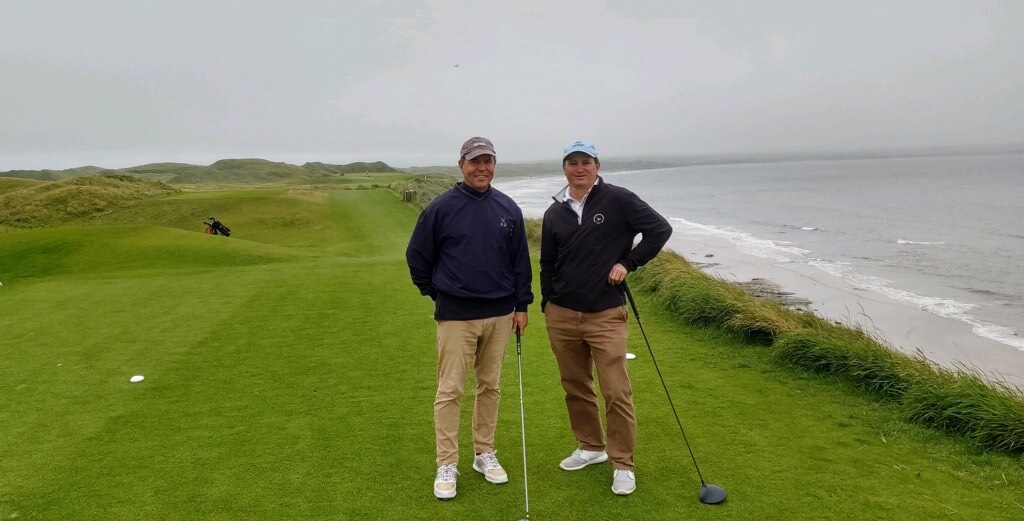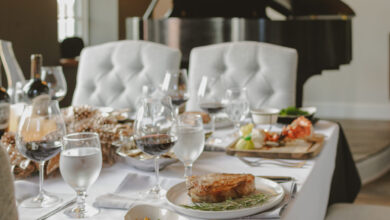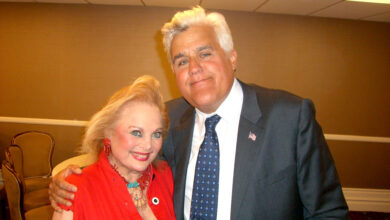Sitting at 30,000 feet above the North Atlantic, I could only ponder what travails awaited upon my arrival in Dublin. My worry was not completely unfounded or unjustified – 21 years earlier while flying above the clouds en route to a golfing adventure, trouble was taking place back home that cut the vacation short before it had even started.
I am a golfer. For a skier, life is incomplete until experiencing the Zermatt in Switzerland; for a surfer, Oahu represents the Holy Grail of waves. As a golfer, some may claim Scotland or even Pinehurst and perhaps Augusta to be the promised land of the game; but for me, Ireland is Mecca.
In 2001, I was set to make my pilgrimage to the Emerald Isle, meeting my friend and his father there for a week that would include rounds on famed venues such as Lahinch, Tralee, Waterville and Ballybunion. Upon landing at Shannon International Airport, I was informed of a medical emergency back home and my friend and father were taking the next flight back to the States. Not wanting my first experience with true links golf to be a solo excursion, I boarded that same flight back home, clutching to the belief that right soon I would return to quench that thirst for golf in its purest form.
A marriage, four children and 21 years of life put that pilgrimage on hold and it seemed it may never happen. But Ireland has a way of winning, of manifesting itself as more than just a siren song but a grappling hook from which you cannot escape, and do not wish to. The hook came in the form of a phone call from my friend, Rob Jordan, who was just days away from returning to Ireland with his father for a fourth golfing trip to the island.
Looks like dad was pulling out at the last moment due to complications in his foot that would make walking the dunes of Irish golf courses impossible. Looks like I was first alternate on the tee, ready to take his spot and Rob’s phone call informed me of such. There were no excuses to turn down the offer: air fare, greens fees, hotels, rental car – all was set, so I just needed to fill in. To not go now would mean to forever close the book on Ireland, so indeed Ireland won.
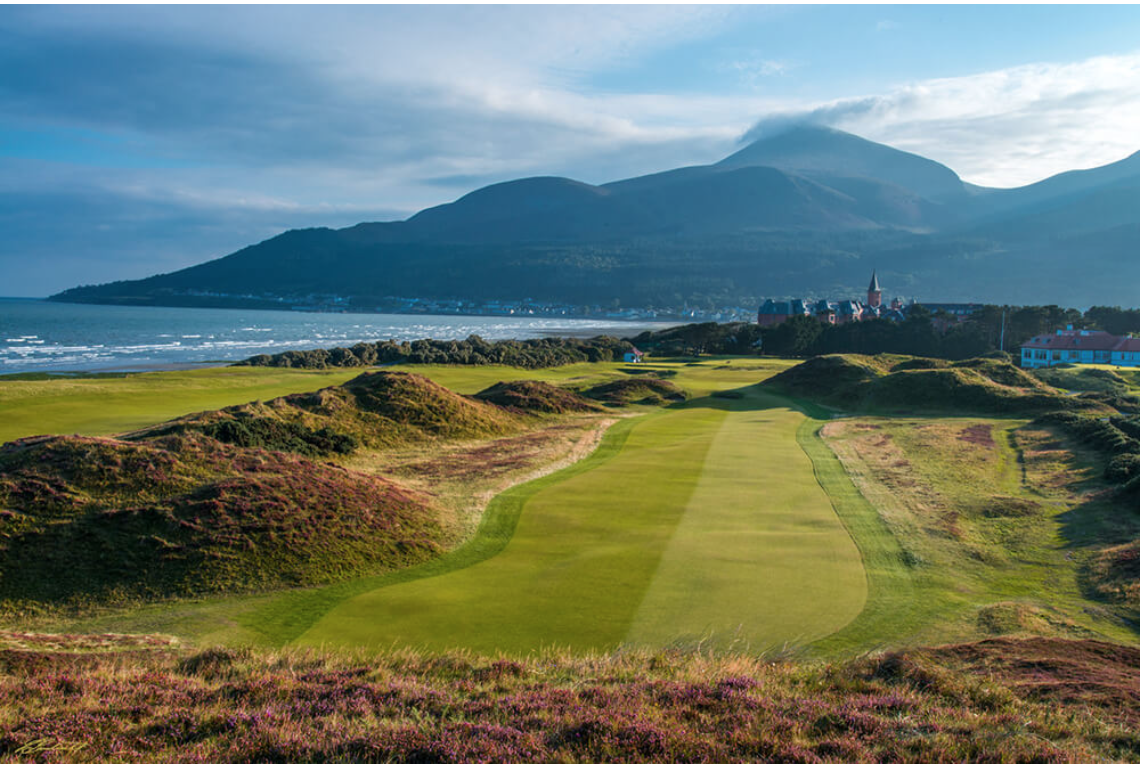
Upon landing in Dublin, no ominous messages from the States awaited us. Looks like this time would be a go and we drove immediately to our first golf stop, The Island Club in Malahide. The first tee shot would go to a fairway guarded by large dunes on either side and I would discover this to be a theme for the rest of the trip. I managed to hit that fairway and make par, a pretty strong start that actually took me by surprise. The rest of the day would not be so friendly.
In golf, the main opponent is one’s self, but in Ireland it seems getting past one’s own physical and mental shortcomings is only the first minor obstacle in a train of beautiful bandits and cozeners, each precariously placed to ambush the unwary player. The terrain presents moguls and potholes as the dermis of a snake that furtively winds its way through those impenetrable dunes. At times the tiny hills throw your ball into a perfect position of which you certainly did not earn; other times they act as ramps to hell. A good caddy can tell you where those bumps generally will take you, but I discovered quickly that for a links newbie, foreknowledge is about as reliable as tumbling dice.
The gambling neophyte entering a casino is often rewarded with blind victories to entice one’s return where he is later entrapped and left for dead on the side of the road. Irish links golf takes the opposite tact: From the beginning, one is belted, flayed and humiliated as though being dared to continue as some initiation hazing ritual. Only after taking a beating and exuding the patience needed to play Irish links golf is one then rewarded with the victories afforded to what are seemingly reserved for veterans only. After a while, those great shots that yielded an unlucky mire turn into poor shots that wind up in some serendipitous fate, in perfect position and the result of a higher knowledge and skill.
In other words, luck is not a residue of design but of time and repetition.
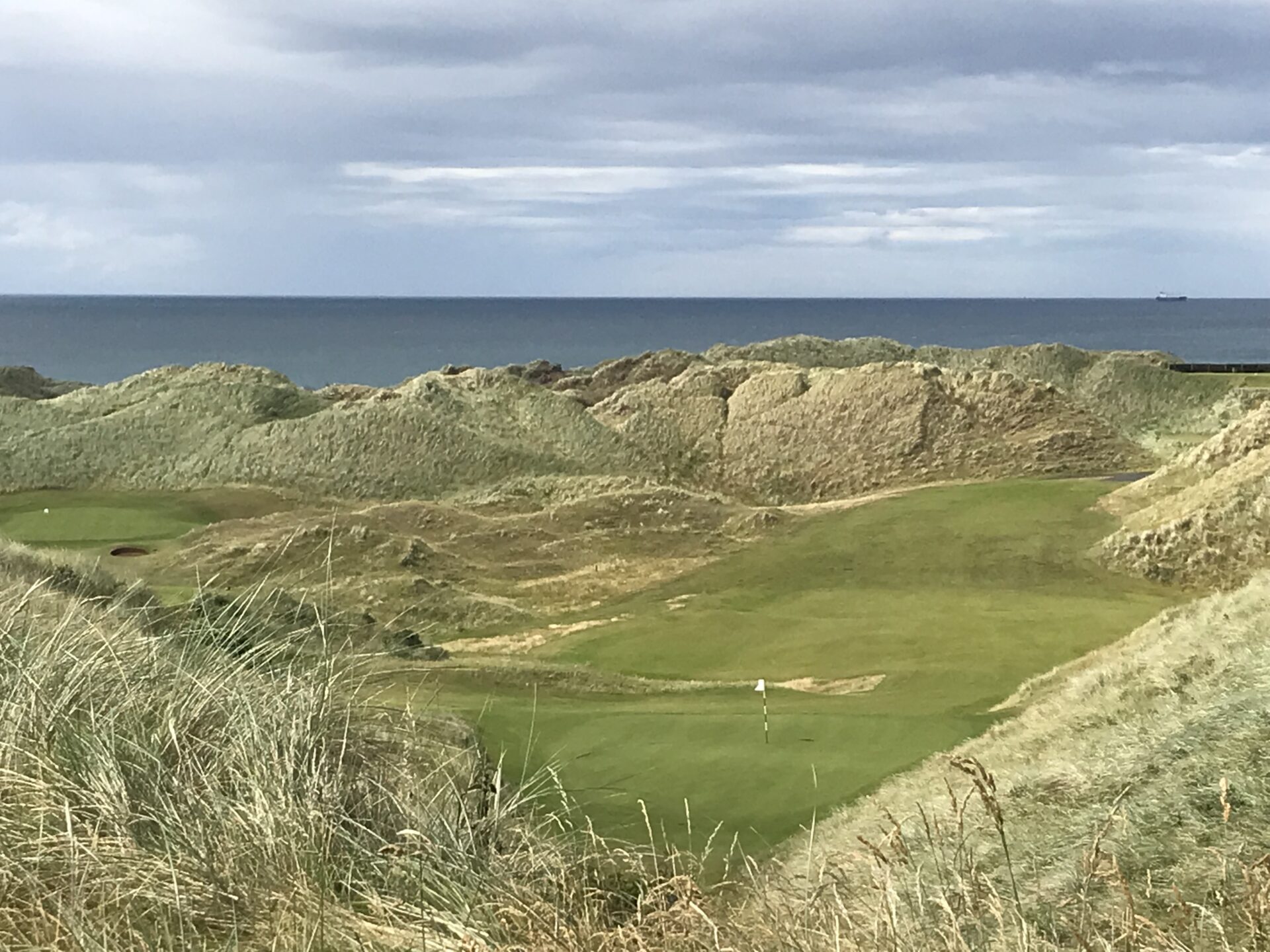
Irish golf is the Taoist’s dream: a mixture of beauty and ruthlessness, of charm and deceit, of man’s harmony and eventually his discord with nature. It is here that one may fall in love with the spectacle of the land and ocean scapes at any given moment while at the same time dread that which confronts him. The views may be hypnotic; the shots daunting.
At a true links golf course, the hand of man plays but a scant role in its design, that duty falling mainly to God, whose greatest masterpiece may have come at our next stop: Royal County Down. With the aptly-named Mountains of Mourne as a backdrop, Royal County Down offers golf shot-making opportunities like no other place in the world. The ninth hole, which locals boast is among the most photographed holes in golf, presents itself as the “signature” hole (an American term if there ever was one). At 486 yards from the back tees, one must play the tee shot over a plateau down a 60-foot drop to the fairway. From there, one hits into an elevated green protected by two bunkers and a large dune to the right; all the while, the mountains loom as a screen saver into which each shot is played.
The test to one’s game, the routing of the holes, the terrain of beaches, dunes, mountains and city backdrops make Royal County Down as special a place I have ever been. When leaving, I knew the rest of the courses on the trip would have a tough time living up to this standard.
On to Royal Portstewart on the northern coast and we would experience the vaunted Irish weather about which I had been warned. The opening hole may be the most memorable experience of mine in 45 years of playing this maddening game.
Standing atop an enormously elevated tee box and staring down at a left-to-right dogleg in which the green is hidden from view, wind gusts of 40 mph made the shot nearly impossible to strike. Like most of the holes in Ireland, this shot demands that one carve the ball slightly left to right and preferably of little altitude, but for those who play a high draw nature’s mercy sorely lacks.
On this day, with howling winds and occasional bursts of a downpour, success meant keeping the ball in play and finishing the hole with an honest score.
For 11 rounds in Ireland, we were lucky or perhaps the myths surrounding the Irish weather were a bit stretched – only five holes total were played in rain while winds consistently remained in the 1-2 club range, sometimes a wee bit more as the local vernacular has it. Wind and terrain force players into a certain type of golf they may not be accustom: hitting the ball low, landing it short and allowing it to run like a scalded dog to the hole. Essentially, the island green is a manufactured beast from the minds of ghoulish Americans and has no place in links golf.
As testimony to the type of golf shots one must play, at one point Jordan played a par-5 hole driver-putter-pitching wedge – all from the fairway. You read that correctly, the second shot lay-up was hit with a putter.
At Rosapenna Golf Resort, three courses exist that uphold Ireland’s reputation quite well. The new St. Patrick’s course revealed its youth as time has yet to allow turf conditions to catch up with the beautiful layout. It is here, though, that one finds incontrovertible evidence of man’s hand: several greens of extreme embankments and mounds speak volumes that much dirt was moved in their construction, more so than one finds at other Irish links courses.
The rest of the trip took us to venues that all lived up to whatever hype had been delivered to me or manufactured in my own mind. Courses like County Sligo at Rosses Point and Enniscrone do not enjoy the publicity of places such as Royal County Down or Portrush, but I feel the trip to Ireland would not have been complete without them. Vistas of the Atlantic, colorful dunes with its purple heather and gorse all complement what are truly outstanding golf holes that demand a variety of shots and not just the low runners.

Like Sligo and Enniscrone, Carne Golf Club in the remote Mullet Peninsula is a dreamy commodity unknown to many players. Jordan refers to the dunes of Carne like the rest of Irish links courses, but “on steroids.” If I didn’t run out of golf balls at Carne, it was only through Jordan’s generosity, his bag well-stocked in preparation.
Eddie Hackett is said to have designed the course, but based on its wild elevation changes and large dunes one might be convinced that Anton Schwarzkopf or Bolliger & Mabillard had a hand in its construction. A stretch of three holes from 14-16 at Carne may have been the most memorable run of holes I have ever played. Each presents elevation such that the approach to the green is from a well-perched position. Hitting down to a target may place a greater premium on accuracy, but it provides an exhilaration unmatched in both its vista and its challenge.
Lahinch Golf Club in County Clare is more famous than Enniscrone or Carne, but still lacks the international status of County Down. As a purists’ venue, though, Lahinch is about as close as you can get to quintessential Irish links golf. Several blind shots may leave some scratching their heads about a certain “quirkiness” to them, but plenty of room on all such shots make them fair.
The most famous of the blind shots at Lahinch would be the par-3 5th, which plays 155 yards uphill and over a dune that completely masquerades the green which sits in a swale. If your club selection is correct and you take it over the stone directional marker, good things happen such that one might be inspired to write a magazine article (wink noted).
Along the way of this odyssey, Ireland offers so much more than golf. Famous for its pubs and chatty citizens, Ireland tempts the soul in many ways. The Cliffs of Moher draw tourists from all over the world, but they are less spectacular than the unsung Slieve League which boasts over twice the elevation.
Giant’s Causeway in Northern Ireland combines a natural geological curiosity with typical Irish folklore. With 40,000 interlocking hexagonal-shaped basalt columns on the shore, the area appears surely to be of either man-made or supernatural construction. Geologists disagree, but the locals love to say the formations are the result of an ancient Irish giant named Finn McCool who built a causeway to Scotland in order to fight a giant there. Most important by my estimation is that the area was used to photograph the cover of Led Zeppelin’s “Houses of the Holy” album.
Famous for its proliferation of poets, Ireland’s landscapes provide the perfect muse for writers. The birthplace of Yeats, Joyce, Wilde and many others lends credence to Ireland’s reputation as a literary giant. But the natural charms and graceful eloquence belie the ugly scars and angst of a people chronically cheerful yet perpetually scorned. Nowhere is that angst more evident than in the city of Derry (or Londonderry, depending on one’s political proclivities) in Northern Ireland, ground zero for upheavals and rebellion for hundreds of years. Murals throughout the city are reminders not of the beauty that surrounds them, but of the oppression and injustice that consumes them. The past decade has brought mainly cessation of sectarian violence, but one cannot step in any direction without constant reminders of the recent “Troubles” as they call them.
Then there are the pubs. One cannot walk a block down any street without passing a Guinness sign there to entice one through some taproom doors. Famous for their whiskey, the Irish people seem more attached to their pints of dark ale than they are the brown liquors.
Twenty years earlier I may have been a livelier participant in the pub scene, but a heart attack and years of wear and tear hath wrought a more subtle approach to my imbibing these days. As such, Jordan was more than happy to place a half-pint in front of me on more than one occasion.
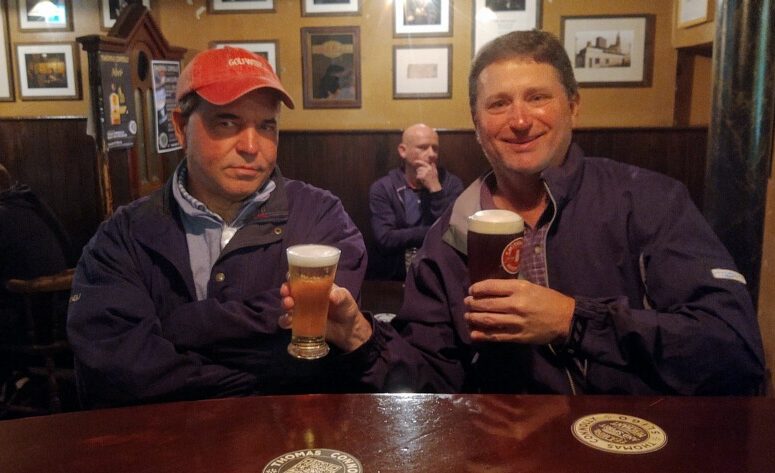
If you want to blend in, do not sit at the bar with a half-pint lest you draw the stares of the locals curious as to your level of effeminacy. Of course, Jordan was all too happy to place the half-pint before me and entertain himself with my embarrassment.
The natural wonders, culture and history aside, I came here for the golf, Ireland’s greatest gift to humanity behind only its literature. And there was no better way to conclude than at Ballybunion.
For me, Ballybunion was the white whale, the ultimate conquest. Not simply the last stop on a golfing trip, Ballybunion represented, in fact, the sole reason for visiting Ireland. The legendary sports writer Herbert Warren Wind may have been the first American to tout the greatness of Ballybunion, but it remained relatively obscure until Tom Watson called it the best golf course in the world back in the early 1980s.
My expectations for Ballybunion were of some gem hiding in an Irish backwater, a bit of an understated cabin nestled at the end of a deserted two-lane highway. It would be golf in its purest, no-frills form. Instead, we were greeted by the most modern of clubhouses like one would expect to find at one of America’s newest mega golf resorts – the industrialized catering to the modern-day golfing gentry.
Crowds were gathered on the clubhouse balcony and as we pulled our clubs from the rental car and changed into our golf shoes we could hear that crowd offer a smattering of applause. “Just what is going on here?” Arriving a little early for our 10:20 tee time, we soon discovered that two dignitaries had wedged themselves into the 10:00 start.
Those would be Rory McIlroy and Tiger Woods, who had helicoptered their way in over the unwashed masses to play a friendly match in preparation for the upcoming British Open. So, we had to play behind these two, but they were never in any danger and proceeded to play through everybody, leaving a vapor trail in their wake. As we teed off on the 12th, we saw the helicopter flee the premises – I guess they did not spend as much time as us looking for balls in the gorse.
As for the course, I have nothing to add in terms of Tom Watson’s assessment. While the clubhouse may be 21st Century, the golf course still maintains its charm built over 120 years. The manicured conditions are befitting of the demands placed by the modern golfer and what Watson claimed over 40 years ago may still be true to many golfers. Although too short for modern professional championship golf, Ballybunion need not ever acquiesce to such a notion – it is perfect the way it is. Many golfers want to play mostly where Arnold Palmer slogged his way to winning a championship or where other ghosts reside, but Ballybunion does not boast a history of pro golf championships to manufacture its lore. The ghost of Payne Stewart, who aced the second hole in a friendly match not long before his untimely death, haunts the place and a plaque exists to commemorate the feat.
Thus, the mystery of Ballybunion. We will likely never witness the Claret Jug be hoisted on the 18th green there, nor will its holes be recognizable as other venues like Amen Corner at Augusta, Postage Stamp at Royal Troon or even the island green 17th at Sawgrass. There is no vicarious way to experience Ballybunion, not even in the pages of a magazine article.
Ballybunion is but a dream, a stranger without a face, until you trod its grounds. Then you are lovers forever.
Special thanks to Mike and Carol Jordan for their kindness and generosity in making this golf trip happen.
